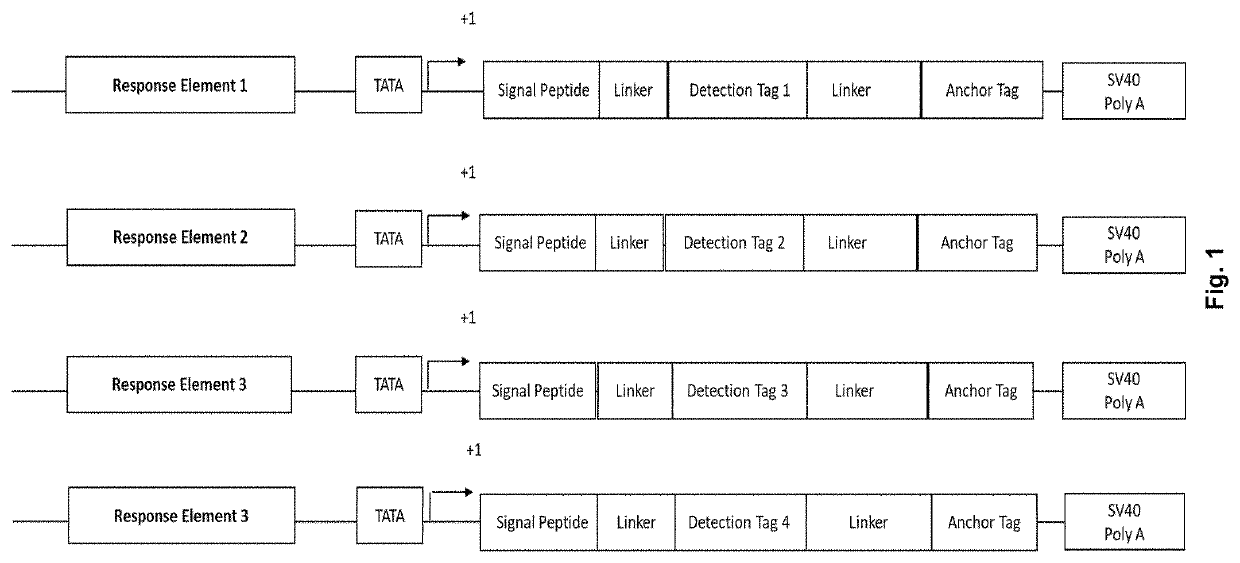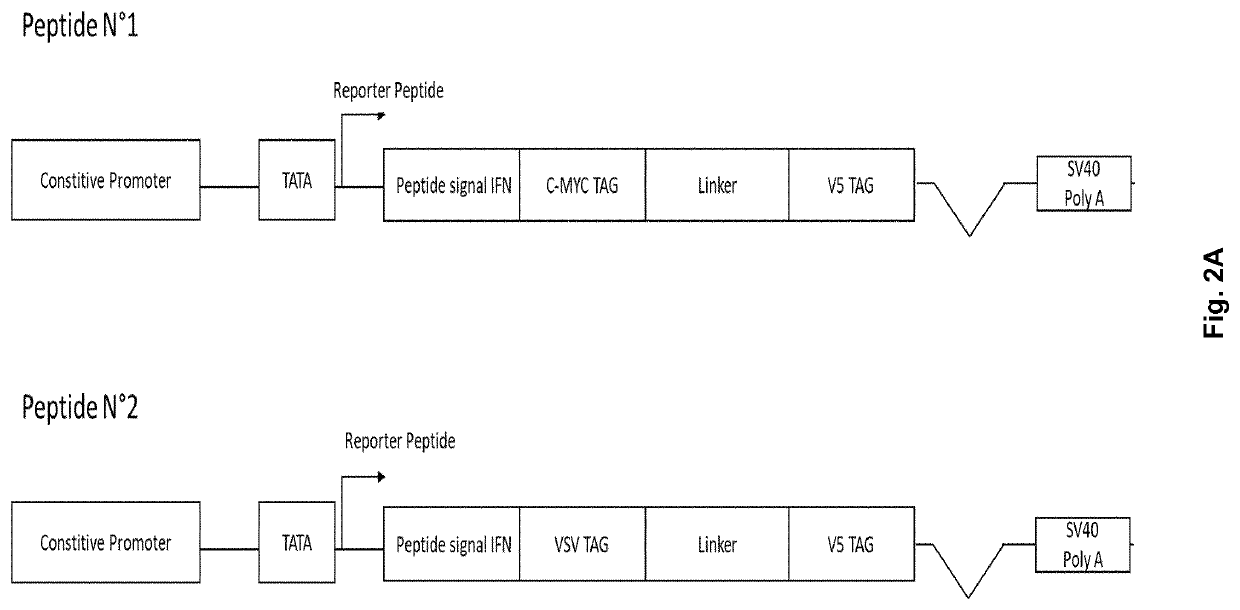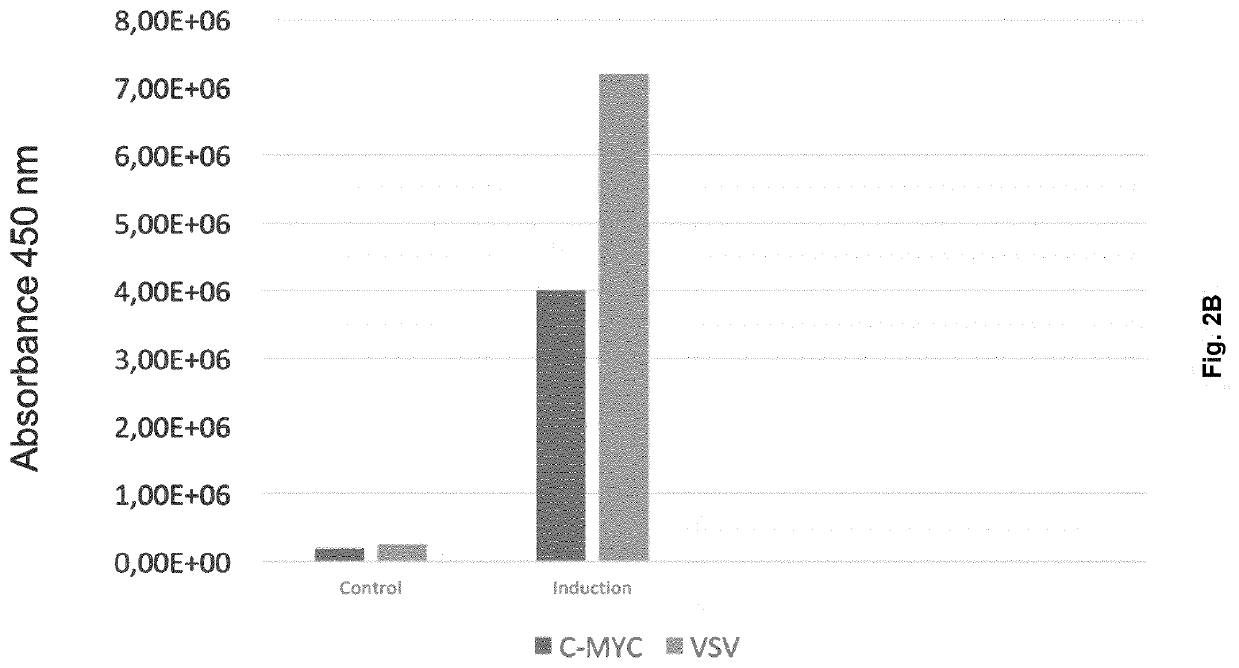Secreted Reporter-Peptides for Optimizing Cell-Based Assays for Analysis on Immuno-Assay Platforms
a reporter peptide and cell-based assay technology, applied in the field of secreted reporter peptides for optimizing cell-based assays for immunoassay analysis, can solve the problems of inability of patients to respond to therapy, severe autoimmune reactions, and immune complex diseases
- Summary
- Abstract
- Description
- Claims
- Application Information
AI Technical Summary
Benefits of technology
Problems solved by technology
Method used
Image
Examples
example 1
[0089]HEK293 cells were co-transfected with the two secreted reporter-peptides shown in FIG. 2A. Each peptide is under the control of a constitutive promoter and carries an interferon alpha 2 signal peptide. Each peptide also carries a peptide derived from the V5 protein of Blue Tongue Virus (anchor tag) and a recognition sequence that is specific for one or the other of the two peptides. Peptide N° 1 encoded by SEQ ID NO.: 1 contains a c-Myc recognition sequence and Peptide N° 2 encoded by SEQ ID NO.: 2 carries a recognition sequence derived from the G capsid protein of vesicular stomatitis virus (VSV). The antibody against the anchor peptide is biotin labelled such that it will attach to a streptavidin coated ELISA plate. The antibodies directed against the detection peptides are labelled with horseradish peroxidase (HRP). The culture supernatants were collected 18 hours after transient transfection of HEK293 cells with both peptides and analyzed using a bridging ELISA consisting ...
example 2
[0090]HEK293 cells were co-transfected with the secreted reporter-peptide according to the invention encoded by SEQ ID NO.: 3 under the control of a cis-acting chimeric regulatory sequence consisting of a 5-fold tandem repeat of the gaI4 upstream activation sequence (UAS) and a TATA box operationally linked to the signal peptide derived from the gene encoding interferon alpha 2, a c-Myc recognition sequence, a peptide derived from the V5 protein of Blue Tongue Virus (anchor tag), and a poly-A tail (FIG. 3). The cells were co-transfected with an expression vector for a chimeric transcription factor comprising the trans-activation domain of Elk-1 fused to a synthetic DNA binding domain capable of binding to the gaI4 UAS cis-acting regulatory sequence of the secreted reporter peptide, and expression vectors for a cell surface bound heterodimeric receptor protein comprising the tyrosine kinase FGFR1c receptor chain and a beta-Klotho co-receptor protein together with the Renilla lucifera...
example 3
[0091]HEK293 cells were co-transfected with a secreted reporter peptide according to the invention under the control of a cis-acting chimeric regulatory sequence consisting of a 5-fold tandem repeat of the gaI4 upstream activation sequence (UAS) and a TATA box operationally linked to a signal peptide derived from the gene encoding interferon alpha 2, a c-Myc recognition sequence, a peptide derived from the V5 protein of Blue Tongue Virus (anchor sequence), and a poly-A tail. HEK293 cells were also co-transfected with an expression vector for a chimeric transcription factor comprising the trans-activation domain of Elk-1 fused to a synthetic DNA binding domain capable of binding to the gaI4 UAS cis-acting regulatory sequence of the reporter peptide, and an expression vector for the cell surface bound VEGFR2 receptor protein together with the Renilla luciferase normalization gene (FIG. 5). A stable clonal cell line was isolated and characterized for VEGF responsiveness. The recombinan...
PUM
| Property | Measurement | Unit |
|---|---|---|
| SPR | aaaaa | aaaaa |
| size | aaaaa | aaaaa |
| length | aaaaa | aaaaa |
Abstract
Description
Claims
Application Information
 Login to view more
Login to view more - R&D Engineer
- R&D Manager
- IP Professional
- Industry Leading Data Capabilities
- Powerful AI technology
- Patent DNA Extraction
Browse by: Latest US Patents, China's latest patents, Technical Efficacy Thesaurus, Application Domain, Technology Topic.
© 2024 PatSnap. All rights reserved.Legal|Privacy policy|Modern Slavery Act Transparency Statement|Sitemap



